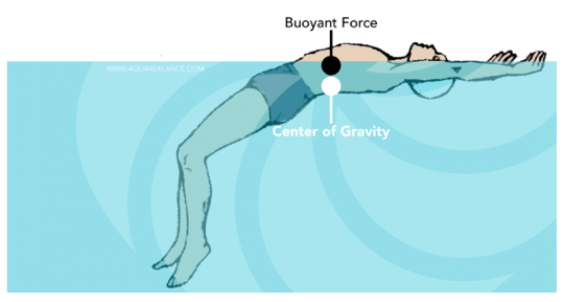- Pull your shoulder back
Pulling your shoulder back will lift your chest up and consequently help raise your abdomen and legs to the surface of the water. - Breathe normally
Keep the flow of air moving in and out of your lungs, DO NOT stop the flow of your breathing. Holding in your breath creates tensions and ruins your buoyancy as your muscles condense and become a dead weight in the water. - Keep body flat/straight
A flat and straight body will ensure you are spread across the surface like a raft creating an ‘upthrust’ from the water below helping you float on top of the water better. - Push chin up, squeeze bum/lift pelvis
This will help keep the body inline and floating on top of the water. If you lift your chin up your legs will follow and come up to the surface. - RELAX!
If you do not relax, your muscles will be tense, your breathing will be compromised and you will not be able to focus on any of the other helpful floating tricks.
Bouguer’s principal
Equal forces of gravity and buoyancy = flotation
Unequal forces of gravity and buoyancy = rotation
When both gravity and buoyancy are vertically aligned in the centre of the body as shown in the first image below you are able to successfully float. When gravity and buoyancy are not vertically aligned a rotational force results shown in the second image below. A rotational force generally causes your hips to sink.


Your body type has a lot to do with your buoyancy. Fat floats, while bones and muscles are denser and are not as willing to float. Also, the relative size of your lungs to the rest of your body determines how high in the water your body will float.
This is a complete beginners guide to floating
Some science first
Firstly you need to understand how your body conducts itself in water. Some of us have excellent buoyancy and others do not. Your buoyancy has a direct link to your density (fat mass, bone mass, muscle mass, fluid mass, etc.).
Beginners will tend to feel the water pulling them down however, the water is actually supporting you.
Stationary floating vs. gliding
FACT: Females generally float better than males
1. RELAX!
If you do not relax, your muscles will be tense causing you to sink, your breathing compromised and you will not be able to focus on any of the other helpful floating tips.
2. Align your body with the surface of the water
Holding the side of the pool with one arm, pull your body on top of the water by slowly reclining allowing your head and shoulders to rest on the water as if you were lying flat in bed. Bring your body into a vertical position ensuring you are lying at the surface of the water like a raft. spread your arms and legs to your sides like a star fish. This distributes your weight across the surface of the water making it easier to float.
If your legs start to sink you can gently kick your legs to keep them higher in the water.
3. BREATHING THE CRUTIAL LINK TO FLOATING
Keep the flow of air moving in and out of your lungs, DO NOT stop the flow of your breathing. Holding in your breath creates tension and reduces your buoyancy as your muscles condense and become dead weight in water.
4. Lift your chin
Pushing y will help keep the body inline and floating on top of the water. If you lift your chin up your legs will follow and come up to the surface.
5. Squeeze shoulder blades together behind your back
Squeeze your shoulder blades together by pulling your shoulders back and drawing them towards your bum. This will lift your chest up and consequently raise your abdomen and legs to the surface of the water.
5. squeeze bum/lift pelvis
6. point your toes